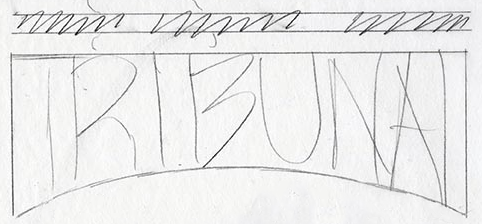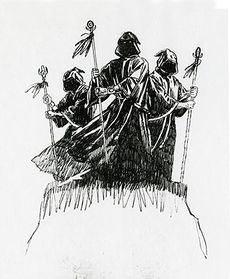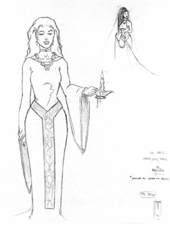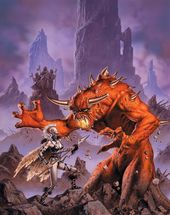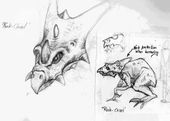General:Tribunal (canceled game)
The UESPWiki – Your source for The Elder Scrolls since 1995
< General: Canceled Games(Redirected from General:Tribunal (XnGine))
Originally, the follow up to Daggerfall would have been a direct sequel with a similar gameplay style and using the same engine. This iteration would have been titled The Elder Scrolls Chapter III: Tribunal, and was initially set in the Sumurset Isles before the setting was moved to Morrowind.[1] This page is meant to document the earliest iterations of the game.
Vision[edit]
Generated vs Handcrafted[edit]
- Julian Lefay, colloquial Father of the Elder Scrolls, had a game design philosophy that astronomically differed from Todd Howard's approach (at the time). In Julian's mind a proper mainline Elder Scrolls game has its world be comparable to real life landmasses, with some hand crafted content alongside generated content from an artificial dungeon master. Todd on the other hand favored highly authored hand crafted game content across the board.[UOL 1]
Originality vs Vanilla[edit]
- According to Julian Lefay, the Morrowind team was hyper focused on originality. He felt that they didn't need to make an original game, they needed to make a good game, and if that features originality in the setting, he thought of that as a passive bonus. Julian believed in the benefits of vanilla flavored content, that people know it, they can just jump in from the get go, and that it is readily marketable to consumers and funders.[UOL 1]
Multiplayer[edit]
- Julian Lefay had designed Daggerfall to be massively multiplayer capable. The concept was that there was nothing in the code to distinguish the player character from any other character in the world. It was all set up so that NPCs could actually be replaced with real players. Of course, this didn't come to pass, but Julian intended on implementing such technology for future Elder Scrolls games,[UOL 1] which he actually managed to implement for Battlespire.
Porting Player Characters and Addressing Daggerfall's Endings[edit]
- Originally, The Elder Scrolls games were meant to follow the Wizadry and Tabletop Roleplaying model where you could continue playing as the same player character throughout multiple campaigns and roleplaying modules. However, when attempting to implement this feature for Daggerfall, the dev team ran into trouble when attempting to port characters from Arena's deprecated skill system into Daggerfall's far more complex leveling system, along with balancing overpowered characters. Ultimately, it proved to be too much of a hassle, and the feature was cut.[UOL 2]
- Ted Peterson stands by the multiple endings of Daggerfall as worthy player choice for roleplaying, he thinks that in video games (a medium of active storytelling) the player's should be allowed to make choices matter and affect the world around them. But he also admits that world altering choices is a problem when making sequels. If he had stuck around to make Tribunal, he would have implemented a save game port function along the same lines as the bullet point above, where perhaps the multiple outcomes of the previous game could result in multiple starts to the sequel game. He also rationalized that any sequel to Daggerfall would have been set in a different location from the Iliac Bay, so you could also port your save and just have the background worldbuilding stuff adjust itself to your past decision.[UOL 3]
- Michael Kirkbride and Kurt Kuhlmann were responsible for the canon "solution" to Daggerfall's endings... Michael had found a timeline of history from Daggerfall's development, presumably the same one that can be found in The Daggerfall Chronicles, and saw this weirdo thousand year gap between two bullet points, and came up with the Dragon Break concept, which was subsequently used to mesh together all the endings of Daggerfall into one event, so every ending became canon, which they called the Warp in the West. Lead Designer Ken Rolston considered the idea a wonderful designer response to the "criminally irresponsible" design scheme of Daggerfall's endings, in a series that was like to have sequels.[UOL 4][UOL 5]
Plot and Setting[edit]
Ted Peterson[edit]
- What we know of Tribunal's story can be attributed to Ted Peterson, who was responsible for laying the worldbuilding foundations for the title, subsequently he threw in a bunch of this brainstorming into Daggerfall via in-game fiction, flavor text, and quests.[UOL 2]
- The titular Tribunal was intended to be Sumurset's three elven rulers, who would have been advised by the Psijic Order...[UOL 6][UOL 7] This germ of an idea was evolved by other designers into the Almsivi God-Kings as featured in Morrowind.[UOL 4]
- The Psijic Order were a circle of mystics native to Isles, who were inspired by the Psionics from Dungeons & Dragons. Taking inspiration from Arthurian Legend, the Psijics home was the Isle of Artaeum, which was imagined to be the mysterious penultimate Avalon esque location of Tribunal.[UOL 8]
- Peterson wrote in fiction, that if one wanted to reach Artaeum, they would have to travel first to one of the "intermediate places" that allowed access to the Isle, kinda like traveling to Diagon Alley in Harry Potter.[2][UOL 9]
- Some in-game fiction written by Ted Peterson featured reference material for the Psijics, including: Fragment: On Artaeum, Mysticism: The Unfathomable Voyage, Galerion the Mystic, and Origin of the Mages Guild.
- Peterson wrote a quest into Daggerfall as a lead in to Tribunal called Morgiah's Wedding, which The Daggerfall Chronicles states will be followed up in the next game.[3]
- The quest concerned the dark elven Princess of Wayrest, Morgiah, eerily organizing her marriage to the high elven King of Firsthold, Karoodil. Somehow, Morgiah became aware that King Karoodil yearned to speak to his deceased son. She offered to help him do this thing, if he were to marry her, a proposal Karoodil accepted. Morgiah subsequently organized the King of Worms's (leader of The Necromancers) involvement in the affair. In exchange for animating Karoodil's dead son, thereby enabling Morgiah's marriage to Karoodil, Morgiah would give the King of Worms her "first," allowing him to exert his influence on the King of Firsthold.[4]
- The "first" mentioned in the quest was conceptually/cleverly intended to make the player think "firstborn", however this would not be the exact case.[3] In Tribunal, Queen Morgiah would be stirring things up, she'd have had a child, and there'd be rumors that the child heir of Firsthold was a changeling. But the player would later discover that this was indeed not the deal Morgiah had worked out with the King of Worms... According to Ted Peterson, it was up in the air as to what the "first" actually was. This plot point would have been notable in the main quest, tying into the corruption of the Psijic Order in some way.[UOL 9][UOL 10]
- Morgiah pursued this because of a romanticized dream... From her point of view the pinnacle one could hope to ascend to would be to join the high elves, with their paradise valleys and crystal towers, and even be their ruler.[UOL 2]
Ken Rolston[edit]
- In 1996, Ken Rolston was hired by Bethesda. After working on a different game for several months, he moved over to laying out the initial designs of Tribunal. At the time, the setting was teetering between maybe Sumurset and maybe Morrowind. The plan that was handed off to Ken by Julian Lefay and company was Sumurset, and he rolled with that. Ken Rolston imagined High Elven society as involving a lot of Elizabethan court intrigue.[UOL 7][UOL 4]
- By quarter four of 1996, the setting had switched to Morrowind,[UOL 11] Ken Rolston transplanted what he could of his designs from the High Elves to the Dark Elves -- the court intrigue in particular, knowing that the Dark Elves in Dungeons & Dragons were particularly participant in such activity.[UOL 7][UOL 4] Given this transplanting of material, it is vaguely possible that the names of the Dark Elven Houses were originally attributed to the High Elves.
Bruce Nesmith[edit]
- In August 1996, it was reported by fans that The Elder Scrolls III would be advance with Bruce Nesmith as Chief Designer, and that the game would be taking place in Sumurset.[UOL 12]
- Sometime during 1996, Bruce Nesmith commissioned Clyde Caldwell to produce a piece of cover art for a very early iteration of Elder Scrolls III, obviously set in Morrowind.[UOL 13] Presumably this occurred after the release of Daggerfall.
Mark Jones[edit]
- In 1996, Mark Jones created some concept art pieces for a creature meant to appear in The Elder Scrolls III, which he intended to name Rock Chisel, Rock Eater, or Rock Biter. The critter was meant to be this organic rock jumping little dude with a beak and a stumpy tail that would burrow into and munch on solid rock to search for food. However, the concept got recycled for Battlespire and got twisted into a demonic being called the Clannfear.
Later Canon[edit]
- Ultimately, most of the intended Sumurset concepts were left on the cutting room floor, with the plot set ups from Daggerfall remaining unfulfilled. Though the scenario with Queen Morgiah and the King of Firsthold was lightly referenced in later texts, like The Firsthold Revolt and The Pocket Guide to the Empire: 3rd Edition.
- Ted Peterson's intended story for Tribunal actually got toyed with quite a bit in the Unofficial Lore scene. For fun, Ted participated in forum-based roleplay campaigns in the mid to late 2000s. In these threads he directly continued the plot established in Morgiah's Wedding, however, the new material was rather contradictory to what was previously established in the quest. Additionally, the story took place in the post-Morrowind continuity, so obviously it's was not exactly what Ted would have done had he designed Tribunal back in the day.[UOL 14]
See Also[edit]
References[edit]
- ^ The Elder Scrolls 10th Anniversary
- ^ Fragment: On Artaeum — Taurce Anselma
- ^ a b The Daggerfall Chronicles — Ronald Wartow
- ^ Morgiah's Wedding quest in Daggerfall
Note: The following references are considered to be unofficial sources. They are included to round off this article and may not be authoritative or conclusive.
- ^ a b c Interview with the Father of the Elder Scrolls by Indigo Gaming
- ^ a b c Interview with Ted Peterson by Indigo Gaming
- ^ Interview with Ted Peterson by ESO
- ^ a b c d Michael Kirkbride's Posts
- ^ Ken Rolston's Posts
- ^ Interview with Ted Peterson by Benefactor
- ^ a b c Morrowind: On Oral History by Alex Kane
- ^ Interview with Ted Peterson by Double Negative
- ^ a b Ted Peterson on High Rock and Summerset
- ^ Ted Peterson's Posts
- ^ Morrowind Concept Map Date
- ^ Daggerfall Unofficial Faq 0.992
- ^ Clyde Cadwell on the 1996 Tribunal Cover
- ^ Loranna's RP
